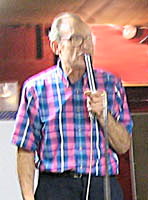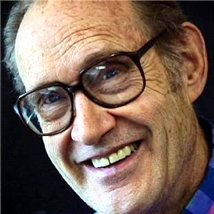|
Ralph Sweet
|
|
CLICK AN IMAGE FOR LARGER VIEW
 Ralph Sweet was brought up in Uncasville, Connecticut (half way between Norwich and New London). His mother had an American Country Dance Society book by Elizabeth Burchenal which was full of contra dances. He couldn't find anybody doing contras except some old timers. Then, as a Junior in high school, he went to a teen-age club which offered some square dance lessons. A couple of years later, Ralph went to the University of Connecticut and joined a 4-H club that had square dance lessons after their meeting. He started going to all the local, traditional square dances where they were doing all singing calls. He later discovered that they were dong a few contras in Brattleboro, Vermont and a few other places.
Ralph Sweet was brought up in Uncasville, Connecticut (half way between Norwich and New London). His mother had an American Country Dance Society book by Elizabeth Burchenal which was full of contra dances. He couldn't find anybody doing contras except some old timers. Then, as a Junior in high school, he went to a teen-age club which offered some square dance lessons. A couple of years later, Ralph went to the University of Connecticut and joined a 4-H club that had square dance lessons after their meeting. He started going to all the local, traditional square dances where they were doing all singing calls. He later discovered that they were dong a few contras in Brattleboro, Vermont and a few other places.
He got into the habit of taking a notebook with him and writing down the names of the dances and the directions for all the dances they called. He went to Hadlyme, Connecticut with Harold Gates calling, and Ekonk, Connecticut with Al Lindell calling. It was Al who pressured Ralph into calling.
Meanwhile, once a year, there was this huge square dance festival at the University of Connecticut on the football field which was marked off in twelve foot squares and they got all the prominent callers from Connecticut. One year, Al Brundage was there with his Hartford Square Dance Club and they did such a spectacular exhibit of The Triple Duck (a takeoff on Forward Six and Back – Right Hand High and the Left Hand Low). This prompted Ralph to learn Modern Western Style Square Dancing.
Ralph joined the National Guard and had the opportunity to learn Kentucky Running Sets in Georgia. He was sent to Master Gunners' School at Fort Bliss in El Paso, Texas where he could square dance three nights a week on various parts of the base; at the regular square dances in town; and at the Square Dance Ranch. He danced to Herb Greggerson, Harold Newsome, and Louie Ratliff as callers there. Later he was transferred back to Boston and danced to Charlie Baldwin's calling once a week at the YMCA, Ralph Page's calling once a week at the YWCA, and Ted Sannella's claling. He then went home on weekends to go to the traditional square dances. He I took up every kind of dancing that was related to square and contra dancing, such as English Country dancing, Scottish Country dancing, and Irish Ceili dancing.
Ralph went back to the University of Connecticut to finish his last two years and Al Brundage was running a beginner class at the Hartford YMCA. Ralph signed up for that class and went once a week to a folk dance club down in Waterford, Connecticut. He decided to take up square dancing a little more seriously took lessons on Tuesday night at Mitchell College. He then taught the same lesson the following night, Wednesday, also at Mitchell College.
Ralph wrote down everything that Al Brundage taught, the order in which he taught it, how he taught it, including his little jokes, thinking that was a wonderful way to get a good start in teaching a class. And he didn't go wrong – it turned into a successful square dance club. It went for quite a while and other clubs branched out from it. It created other callers – Ted Perkins for example – and a few others.
Ralph obtained a job as a Test Engineer at Hamilton Standard in the aircraft industry and commuted to New London. It was at least sixty miles and he finally gave up the square dance club. Meanwhile, he started a square dance club in Enfield, Connecticut called the Enfield Square Dance Club and the Sixteen Acres Club hired him in Springfield and the Farmington Valley Club hired him in Simsbury to be their club caller and class teacher.
Ralph was hired by the Glastonbury Square Dance Club and was busy five or six nights a week calling and teaching classes and working all day as an Engineer. He visited Square Acres where Howard Hogue and Chet Smith had the Bay Path Barn. This prompted Ralph to become the owner of his own barn. He bought a rundown barn of sound construction which was built about 1845 by the Hazard Powder Company. The historical Powder Mill Barn in Hazardville (Enfield) Connecticut supplied 40 percent of all the gunpowder used during the Civil War. Ralph's family spent about a year ripping out the horse stalls and converting the upstairs so they could live in it and converting the downstairs into a dance hall with a nice maple floor. They opened in 1959 and called it the Powder Mill Barn. This rental hall is now a favorite spot for weddings, birthday parties, receptions, showers, meetings, auctions, dog obedience classes, contra dancing and square dancing.
After seven years in engineering, he gave up the engineering job to make a living calling square dances in his own barn. He thought that would be just the ideal situation and would be in heaven. He just couldn't seem to get enough customers, however, to really make enough of a living for a wife and four kids at the time. He tried calling for a living for two years. He had dance classes, two of the western style clubs, the Powder Mill Puffers and the Powder Keg Squares, and tried to do the old time square dancing. He also taught for the Glastonbury Square Dance Club for three or four of years.
Ralph finally decided he wasn't actually making a living and went into school teaching because that would take a little less of his time and he would have the summers off to work at the Barn and do calling jobs. He ended up teaching general science, math, and physics in East Granby, Connecticut and later on in East Hartford. He taught for twenty-nine years.
Ralph was active in the Fife and Drum Corps, also, and wrote a fife instruction book, The Fifer's Delight. He did a lot of work with the Connecticut Square Dance Callers and Teachers Association, started by Al Brundage. He became active in the Springfield, Massachusetts Callers Association which was started by Earl Johnston.
Ralph said that Dudley Laufman was responsible for more growth of contra dance world than anybody in the country. Dudley was from Canterbury, New Hampshire and had a monthly dance in South Amherst. Ralph went there once a month and wrote down everything he did.
Ralph ran into some people in Woodstock, Connecticut that were doing English Country dancing and a little bit of contra dancing on their own in people's homes. He started having twice-a-month contra dances at the barn and they turned out to be quite successful with eighty to one hundred people twice a month. They just kept picking up more and more people and they were more and more successful. They started dances in Hartford with Frank VanCleef who taught English Country twice a month and then Ralph twice a month with other callers – all with live music.
With the appearance of the Bicentennial from 1973 to 1975, Ralph was with the Nathan Hale Fife and Drum Corps. One of their dancers, Kate Van Winkle Keller, was very active in resurrecting old dances and music. So, they formed the Village Assembly and put on exhibitions in Colonial costume. Kate Teller and Ralph cooperated on writing the book Twenty-Four American Country Dances of the Revolutionary Era which was published by the Country Dance Society along with a long-play record.
Ralph made a couple of fifes just to see if he could and if they could use them in the band. Walter got to playing one and and people kept saying, "What is that instrument your son is playing? How can I get one of those?" Ralph thought he would buy a lathe and start making them out of wood. A lathe and then a drill press and then more and more machinery and, all of a sudden, he was making those fifes and they were selling like hot cakes.
Ralph was associated with the New England Folk Festival and exhibited his flutes there. Ralph had played the piano, had taught himself to play the chords on the accordion, and learned all the contra dance tunes on the fife. They obtained a fiddler and Ralph taught his son Walter to play the fife, another teen-ager to play the piano, and they created the Fifer's Delight Band.
Ralph passed away on June 20th, 2019.
